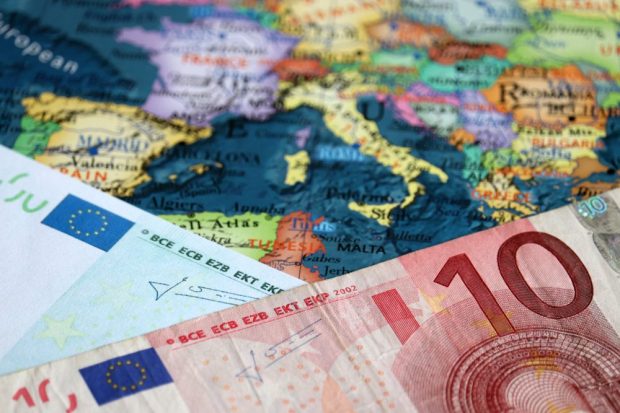Simplicity and Connectivity Seen as Standardized B2B Payments Advantages

For B2B eCommerce firms, options to easily process high-value online payments are few.
“Cards are not made for that. We know that the average [limit] is around €1,500 and €3,000, so obviously [merchants] can’t use that in a business context,” Tarik Zerkti, CEO at Paris-based financial services firm PRETA, a subsidiary of pan-European clearinghouse EBA Clearing, told PYMNTS in an interview.
What businesses normally tend to do, Zerkti said, is to send invoices they’ve received to accounting and have them go through an Enterprise resource planning (ERP) system for payment — a process that can be friction-filled and very time-consuming for businesses.
For eCommerce business-to-business (B2B) players and corporates faced with this challenge, PRETA’s MyBank solution is aiming to fill that gap, offering a pan-European account-to-account (A2A) solution that allows them to receive wire payments from their customers without any limit on the amount transacted.
Another core feature of MyBank is its ability to remove friction around end-to-end invoice reconciliation, Zerkti explained further. “If you are a corporate that wants a straightforward process whereby payments received are formatted in a way that is Single Euro Payments Area [SEPA] compliant and can be entered directly into your accounting system for easy end-to-end reconciliation, [then MyBank helps you solve that].”
And it’s not just businesses who stand to benefit. For consumers, he pointed to the way the solution minimizes friction in the purchase journey, enabling them to pay from their online banking without having to register, create a new password or enter their payment details.
“The idea is to be next to Visa, MasterCard or PayPal or any other payment solution that is available on a merchant’s checkout page,” he noted, adding that once the MyBank option is selected, a user will be redirected to their own online banking portal, where the transaction details are already prefilled. All that remains is to approve the instant wire transfer, after which both the payer and the payee will receive a real-time confirmation of the payment.
“If you want to buy a €10,000 Louis Vuitton bag for yourself and you have that money in your account, you can pay without being [constrained] by your credit card limit,” Zerkti said.
The solution also offers secure and streamlined payments to local and national public administration entities accessible for all individuals and businesses, whether it’s paying taxes and fines, wiring tuition fees to universities, or paying household utilities such as water, electricity and gas.
“Again, if you have solutions like cards or wallets like PayPal, the market share is not high enough to reach all citizens. Not every citizen has a credit card. Not every citizen has a PayPal account,” Zerkti argued.
An Alternative to Open Banking
The open banking scheme, the regulation mandated by the European Union’s Revised Payment Services Directive (PSD2) to give non-bank third parties access to customer account information through banks’ application programming interfaces (APIs), has empowered customers to make informed decisions when managing their accounts.
But according to Zerkti, the technology still remains a friction-filled process requiring the introduction of third-party providers in the payment process.
With MyBank, however, “It’s between you and your bank,” he said, adding that unlike open banking, the fact PRETA has a contract with every bank in the MyBank payment scheme makes a huge difference for merchants.
“Today, open banking is actually a myriad of banks that have their own APIs, and as a merchant or [payment service provider] that wants to connect to all banks in Europe, it’s a nightmare because you have thousands of different connectivity methods that you have to maintain,” he pointed out.
This is where MyBank comes into play, offering a standardized technical approach to each of the banks in its network, which Zerkti said is “of added value for merchants, corporates, public administrations and their banks.”
Moving Forward
In 2022, MyBank closed the year with a record total annual transaction value above €10 billion (about $10.68 billion), a 38% increase compared to 2021.
According to Zerkti, this milestone, achieved as MyBank celebrates its 10th anniversary in 2023, is proof that the solution remains a strong contender among payment platforms providing complete end-to-end digital payment solutions. And this is not just in the B2B space, he noted, but also for business-to-consumer (B2C) transactions in the travel, luxury goods, real estate or automotive space.
For example, MyBank counts German automaker Mercedes-Benz among the 14,000 businesses and brands that have made the solution available to their customers, allowing dealers to obtain a ‘compliance certificate’ that allows them to sell a car to an end user and instantly pay for vehicles online via MyBank without having to go to a bank.
But the firm is not resting on its laurels, he said, and moving forward the goal is to add more participating acquiring banks and payment service providers (PSPs) to the MyBank payment network to top up the 70 new PSPs from 20 European countries it added last year, all while expanding into new European markets.
“We’re still missing a number of [key] acquirers on the market and we have to work hand in hand with the participating banks to bring them on board because the potential [of MyBank] has not yet been achieved on the B2B side and in the public administration domain,” Zerkti said.
For all PYMNTS EMEA coverage, subscribe to the daily EMEA Newsletter.
